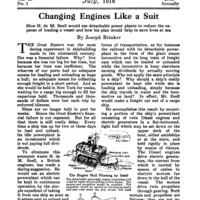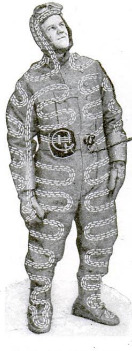Aviators, Electrically-Clad, Defy the Cold
Item
-
Title (Dublin Core)
-
Aviators, Electrically-Clad, Defy the Cold
-
Article Title and/or Image Caption (Dublin Core)
-
Aviators, Electrically-Clad, Defy the Cold
-
Caption: Clothed in this suit, the aviator has no fear of extreme cold
-
extracted text (Extract Text)
-
B-R-R-R! It was cold—so
cold that the watch of a
sentry in the Allies’ camp had
stopped. He pointed com-
miseratingly at the aviator
who was soaring aloft in the
driving snow storm.
“That fellow’s going to suf-
fer more than we are,” he re-
remarked to a companion, ‘‘go-
ing way up among the clouds.”
The sentry’s sympathy did
not seem out of place in view
of the fact that at high alti-
tudes (8,000 to 20,000 feet)
the temperatures are freezing, even in mid-
summer, and that some aviators who fight
at 20,000 feet are as cold as the men who
reach the North Pole. But, as a matter
of fact, the airman was probably much
more comfortable than the soldiers on
the ground below him. For he was
snugly clothed in an electrically-heated
garment. Electrically-heated shoes kept
his feet warm, and he wore an electrically-
heated hood and gloves.
The garment was provided with three
circuits or coils wrapped in the fabric
of the cloth. They encircled his body.
These circuits, which were parallel with
one another, were distributed so that all
parts of the garment were heated when
they were connected up, a corresponding
warmth being produced in the shoes,
hood and gloves. The windings extended
through a switch mounted on a thermo-
stat made to expand under heat. In the
insoles for his shoes as well as in the
gloves and hood were wires connected
with the windings of the garment. Cur-
rent from a storage battery was supplied
by adjusting a contact screw.
After a time the temperature of the
garment rose to such a point that the
thermostat began to expand. This oper-
ated the switch and as a result
the contact point of one of the
coils in the garment was drawn
away from a contact point
connected with the main cir-
cuit, cutting off the current.
Further expansion of the ther-
mostat cut off the circuit of
another coil in the same way,
and as the temperature con-
tinued to increase the heating
power of the third winding was
taken away. Then the tem-
perature of the garment began
to lower again, permitting
the circuits to be reconnected.
Thus the temperature of the
cold dispeller was automatic-
ally regulated. The thermo-
stat mechanism was enclosed
in a casing and placed where
the temperature of the gar-
ment caused it to operate.
So, you see, the sentry’s
sympathy was wasted. As a
matter of fact, every aviator
is clad to resist cold.
-
Language (Dublin Core)
-
eng
-
Date Issued (Dublin Core)
-
1918-07
-
pages (Bibliographic Ontology)
-
36
-
Rights (Dublin Core)
-
Public Domain (Google digitized)
-
Archived by (Dublin Core)
-
Filippo Valle
-
Alberto Bordignon (Supervisor)
 Popular Science Monthly, v. 93, n. 1, 1918
Popular Science Monthly, v. 93, n. 1, 1918



